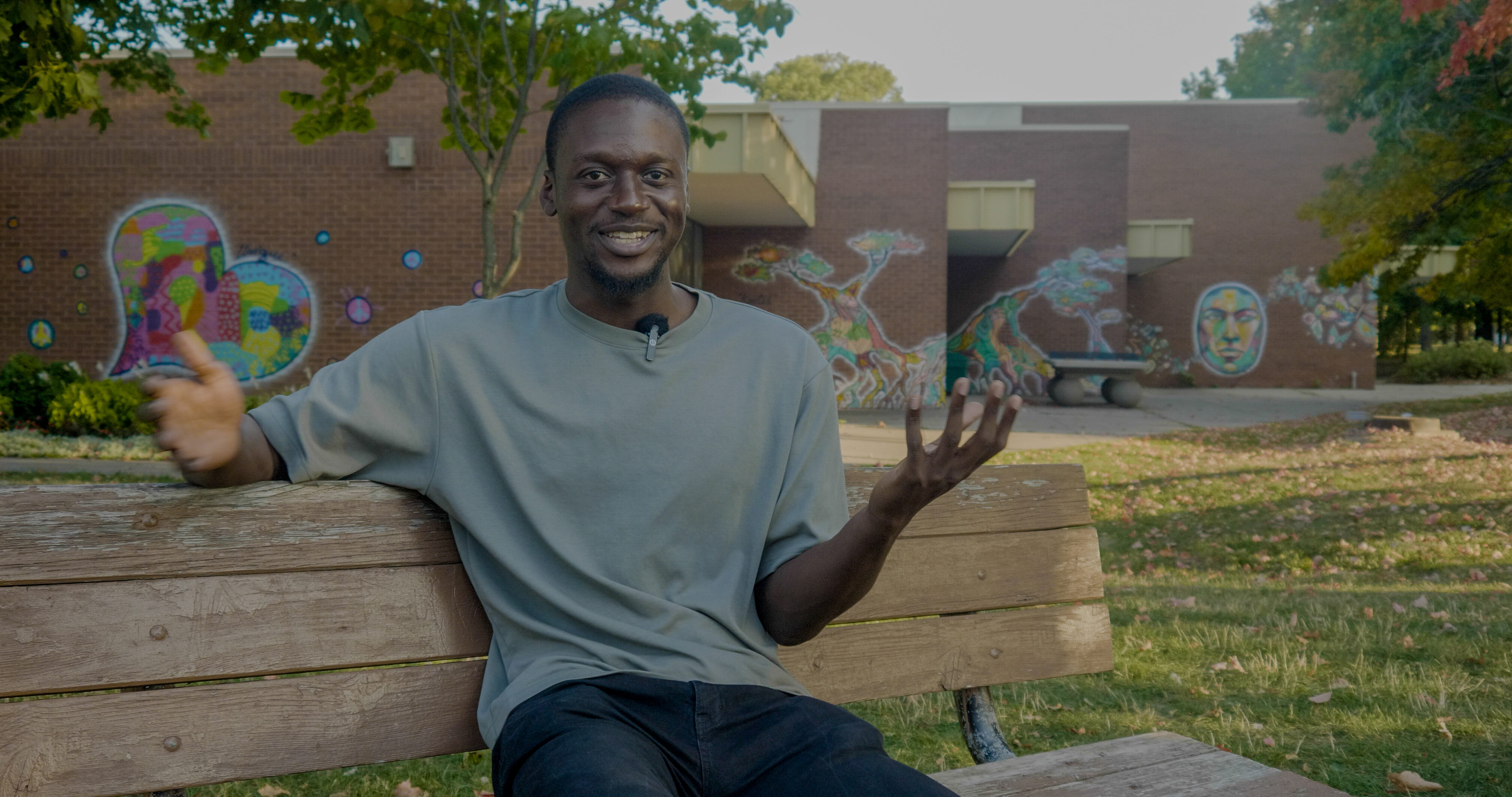THE GREEN LINE
ORIGINAL STORY
‘This is our church’: Why Indigenous fire-keepers want to spread their sacred flame across Toronto
A group of seven fire-keepers in Mount Dennis supports vulnerable members of the city's Indigenous communities, amid the development of the Eglinton Crosstown West Extension
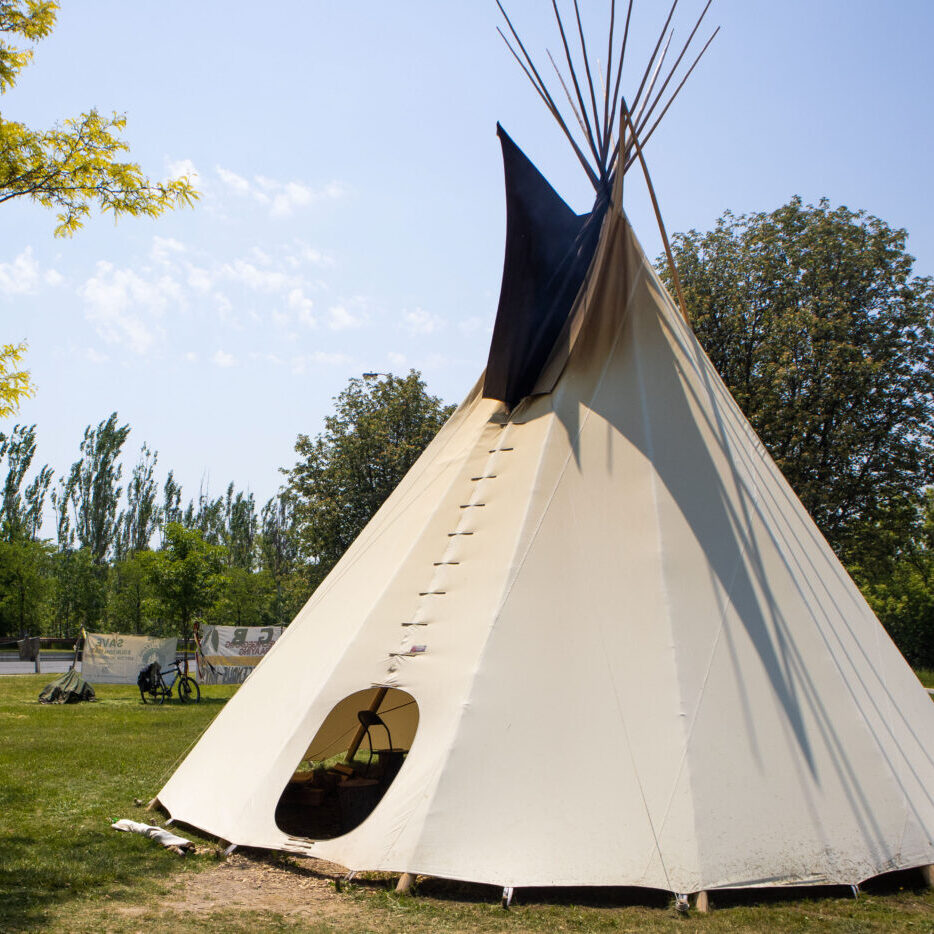
THE TIPI AT PEAREN PARK.


CAMILLA FARAGALLI
Freelance journalist from the Annex. Graduate of Centennial College’s post-graduate journalism program. Focused on social issues and the words we choose to tell our stories.
July 6, 2023
Since the dark, frigid days of late January, a sacred fire has brought warmth to the Mount Dennis community.
A local effort to protect the trees that Metrolinx plans to remove for development work has evolved into something more — namely, a gathering place for members of a fragile community to mourn, pray and heal.
The Turtle Island Carers of Fire (TICOF) are one of seven groups that comprise an Indigenous-led coalition that formed in response to Metrolinx’s planned development of an elevated section of the Eglinton Crosstown West Extension (ECWE). The unnamed coalition, initially led by the Eshkiniigjk Naandwechigegamig, Aabiish Gaa Binjibaaying (ENAGB) Indigenous Youth Agency, is working to protect roughly 1,500 trees in Pearen Park, Fergy Brown Park, the Eglinton Flats and the Humber River area. Metrolinx says the removal of the trees is necessary to erect a 1.5-kilometre concrete structure that would form the aboveground portion of the ECWE.
“A lot of people and media outlets have called it a protest — have called it a blockade,” said Neiland Brissenden, spokesperson for Stop the Trains in Our Parks (STOP), an advocacy group that’s part of the coalition. “But from our perspective — from the Indigenous-led coalition’s perspective — it’s a protection. We are exercising our right to protect the green space within our community.”
The Indigenous-led coalition is also exercising its right to hold ceremony, in a traditional way, with sacred fire. Housed by one of two large tipis on the site, the sacred fire in Pearen Park near Weston Road and Eglinton Avenue West hasn’t been extinguished since it was first ignited in late January.
In 2022, the City of Toronto first opened three designated sites for First Nations, Métis and Inuit peoples to hold sacred fires: Allan Gardens, Christie Pits Park and Norwood Park.
MEMBERS OF THE GERMAN FOLK BAND MILKY CHANCE VISIT THE TIPI AT PEAREN PARK ON MAY 31 IN A DEMONSTRATION OF SOLIDARITY WITH THE COALITION THAT IS PROTECTING THE LAND FROM METROLINX’S ECWE DEVELOPMENT.
🎤: “Soar,” performed by Spirit Wind (Women hand-drum singers)

'A SAFE PLACE'
The practice of sacred fire-keeping exists across many Indigenous cultures.
Often used in birth ceremonies, grief ceremonies and coming-of-age ceremonies, fire is traditionally understood to be a sacred gift from “the Creator,” as well as a doorway of communication with the spirit world.
“This is our church,” said Melvin Pine, one of the seven firekeepers that make up TICOF and a member of Whitefish River Nation, Birch Island.
Fire is also often used in ceremonies to honour relationships to the land and water.
“An elder comes and lights the fire, explains and asks the Creator for whatever they ask for, whatever they pray for,” explained Barry Chevrier, a TICOF fire-keeper who is half-Swampy Cree from the Moose Cree First Nation and half-Algonquin from Timiskaming First Nation. “And that's how it's done; you keep it going 24-7, for as long as the ceremony takes.”
For many Indigenous peoples living in Toronto and other urban centres across Canada, opportunities to connect with the spirit world, the natural world and even each other can be few and far between. TICOF helps urban Indigenous people reconnect with their culture through traditional teachings and practices. They bring elders, knowledge-keepers and fire-keepers together with vulnerable community members, and offer a safe space that’s open to all.
“We have a lot of people [here] that are victims, be it of physical abuse, mental abuse,” Pine explained. “[Fire-keepers] have to be sensitive to those people, and being sensitive to their needs means providing them a safe place.”
As a result of Canada’s history of colonization, exploitation of Indigenous land, and strategies to assimilate or even eliminate Indigenous communities, many of the First Nations, Inuit and Mètis people living in Toronto are affected by trauma, ongoing oppression, racism and discrimination. This has led to disproportionately high levels of homelessness, community violence, unemployment, food insecurity, substance-dependency, mental illness and loss of culture.
“There’s a need in the community,” Pine said. “We talk about the ills in the Native community as a result of the ‘60s Scoop, as a result of residential schools, the result of how society sees Native people in a racist way — our people were destroyed.”
Since TICOF formed, it’s begun a community-outreach initiative that ranges from offering a safe space for people to pray, grieve and heal, to providing mediation and harm reduction in a traditional setting. “We need to break that cycle that our past generation lived in. We need to break that cycle for young people today,” Pine added.
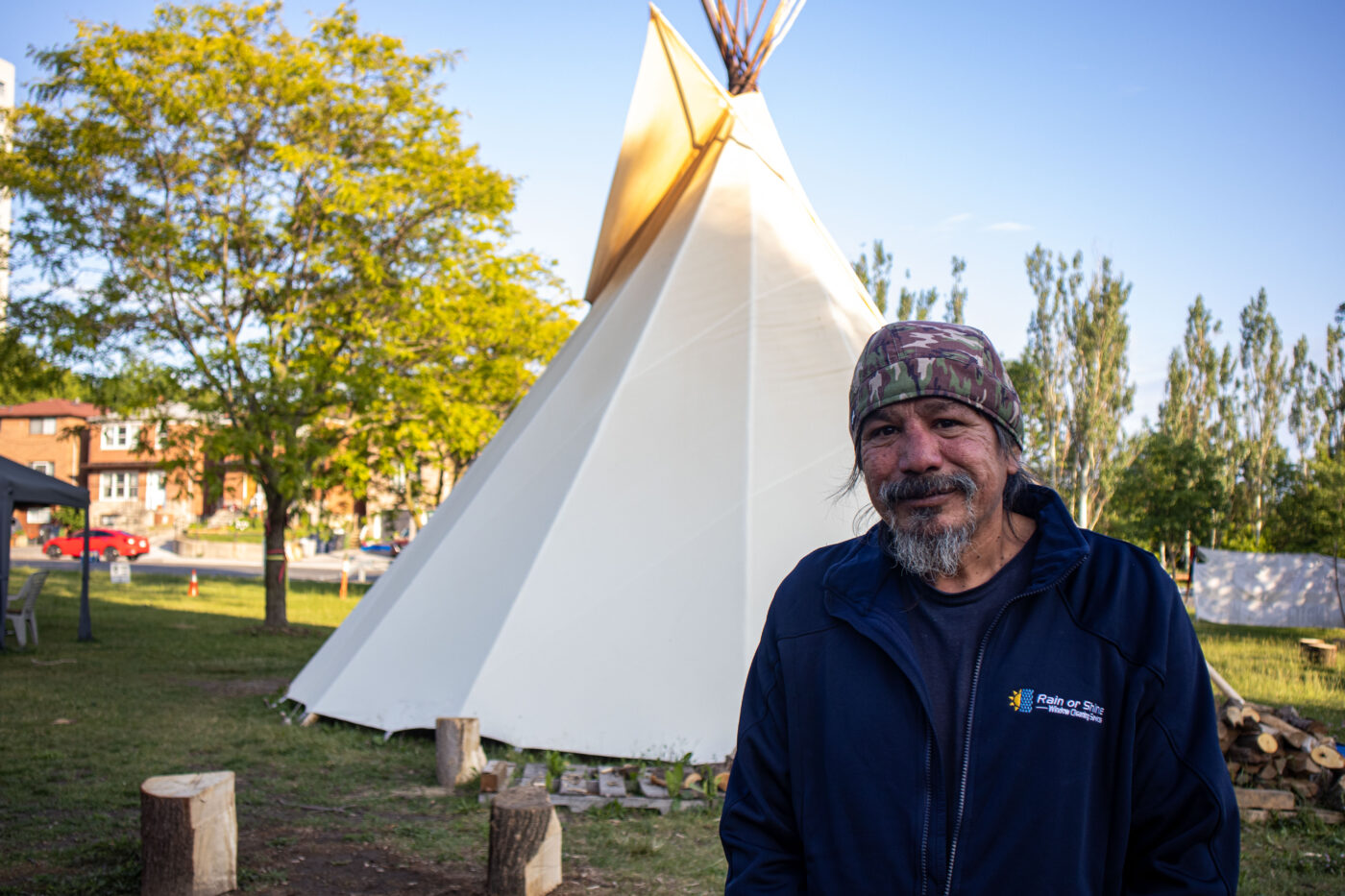
TURTLE ISLAND CARERS OF FIRE (TICOF) FIREKEEPER MELVIN PINE BY THE TIPI AT PEAREN PARK. PINE IS ONE OF SEVEN FIREKEEPERS THAT FORM THE TICOF GROUP.

Beyond fire-keeping
Pine explained that fire-keeping is a greater responsibility than just preventing the fire from going out.
The fire-keepers are responsible for keeping both the area around the fire and the people in attendance safe, and for clearing the grounds of alcohol, drugs, cameras and cellphones (these items are traditionally prohibited around sacred fires, and Pearen Park is no exception).
“People come here and grieve,” said TICOF fire-keeper Chevrier. “But when they come to the fire, we talk to them and they talk to us....They pour their heart out to us.”
He added that people’s spirits are often visibly lifted after visiting the site.
Sarah Matthews is a Swampy Cree woman who moved to Toronto from the Timmins area in 2003. “I wasn’t feeling too well, and I got out of the hospital, and my cousin brought me here,” she said after visiting the fire for the first time in June. “They’re helping people here, with their safety and with their well-being.”
“The whole experience, the people and the place, is one of grace.”
Grainne ODonnell
Volunteer, Toronto Nature Stewards
Although TICOF has prioritized helping urban Indigenous people, the group’s efforts are also appreciated by non-Indigenous members of the Mount Dennis community.
“I have passed by the fire-keepers many times, and at first I wasn’t sure about intruding,” said Grainne ODonnell, a neighbourhood resident since 2008 and volunteer with the Toronto Nature Stewards. “But not at all – there is great generosity of spirit in the fire-keepers.”
ODonnell, who sat in the tipi several times and also brought friends, added, “We felt nourished by the peace within the tipi. We are always rushing around, and it gives you a moment to be still with yourself. The whole experience, the people and the place is one of grace.”
TICOF strives to honour the Seven Grandfather Teachings — principles of character that emphasize the importance of living with courage, love, wisdom, respect, truth, honesty and humility — which are traditionally passed down orally by elders among Indigenous groups across North America.
“I got a call from someone in the community; they asked me to come up and be a fire-keeper,” Pine recalled. “I came up here and I started keeping the fire for 'Nabi [ENAGB Indigenous Youth Agency], and they were paying the honorariums, and they had the funding for it.”
The honorariums that he and the other fire-keepers had been receiving through ENAGB for their time (as well as their funding for supplies like wood and water) ran out in April, according to Pine. So, uncertain as to whether more funding would arrive, a group of fire-keepers continued to maintain the fire on a voluntary basis.
“It’s an honour to be a fire-keeper,” Pine said. “And because this fire is lit 7-24, it’s different from the typical sacred fire at a powwow or other event; this particular fire brings people here that need to be here.”
TICOF has applied for government funding, though it currently relies on donations from community members and groups.
“We got big goals for the future,” Chevrier said. “I wanna be out there throughout the city doing it all over every community, if we can.”
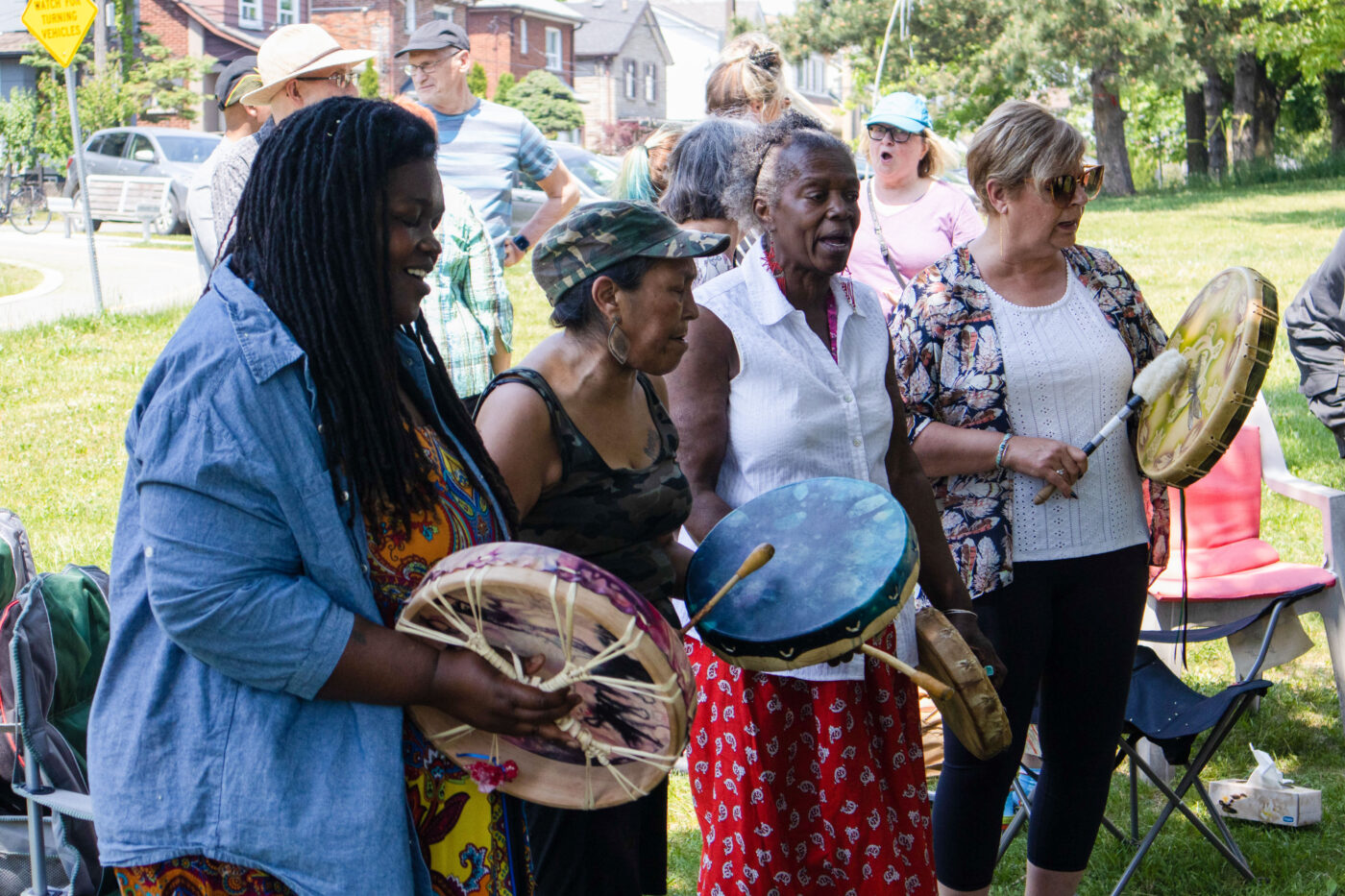
TICOF FIRE KEEPERS (FROM LEFT) MICHELE PERPAUL AND ANNA SAMAYUELLIE MID-SONG AT PEAREN PARK ON MAY 31. PERPAUL LEADS SINGING AND DRUMMING CIRCLES EACH WEEK AT THE SACRED FIRE.

A green space
The green space that TICOF strives to protect is valuable to the Mount Dennis community in several ways, according to STOP spokesperson Brissenden.
“This is an at-risk neighbourhood,” he explained. “A lot of kids live in single-parent households, or they come from two parents who are working constantly.”
As a parent himself, Brissenden said Pearen Park is one of few parks in the neighbourhood that parents feel comfortable allowing their children to play in without supervision. The green space also includes areas where ENAGB and its Indigenous youth have built lodges to use for ceremony, education and to reconnect with the land.
According to Brissenden, the urban forest is a sensitive ecosystem, wildlife corridor and migratory bird route, as well as a natural flood protector, an erosion protector and a sound barrier. It’s also home to threatened and endangered species of animals.
“It’s not a huge urban forest; it's about 50 metres wide by about 2 kilometres long,” he said. “But it does a lot for our community, it does a lot for our Indigenous partners, it is worthwhile saving and it’s something that we believe can be saved.”
The coalition of which STOP is a part identifies themselves as “pro-transit,” and is calling for Metrolinx to take the construction completely underground.
“We know based on Metrolinx’s own information that there are other viable options that would be better for the community,” Brissenden explained, adding that in February 2020, Metrolinx released an initial business plan with several “completely feasible” options for the ECWE development, including that of running the whole line underground.

A MAP SHOWING METROLINX’S PLAN FOR THE ECWE (THE BLUE PORTION OF THE LINE IS WHERE THE ELEVATED SECTION OF THE LRT WILL BE BUILT).

When asked for comment, a representative for Metrolinx told The Green Line that the area around Eglinton Avenue West between Scarlett Road and Jane Street is an identified flood plain that’s experienced historic levels of flooding. “Flooding risk poses unique challenges to building and operating underground infrastructure in the area, which is why elevating the line here makes the most sense,” the rep wrote via email.
Metrolinx added that the ECWE will see nearly 70,000 riders per day, providing transit access within a 10-minute walk to 4,800 low-income Torontonians. “It will also have significant environmental benefits, including annual reductions of up to 5,800 tonnes of greenhouse gas emissions and, when combined with the Eglinton Crosstown LRT, will take nearly 6.5 million car trips off the road annually.”
Around 8,500 new trees will be planted as part of the compensation for the tree removals needed to build the project — 3,500 of which will be on-site in the Mount Dennis area, according to Metrolinx.
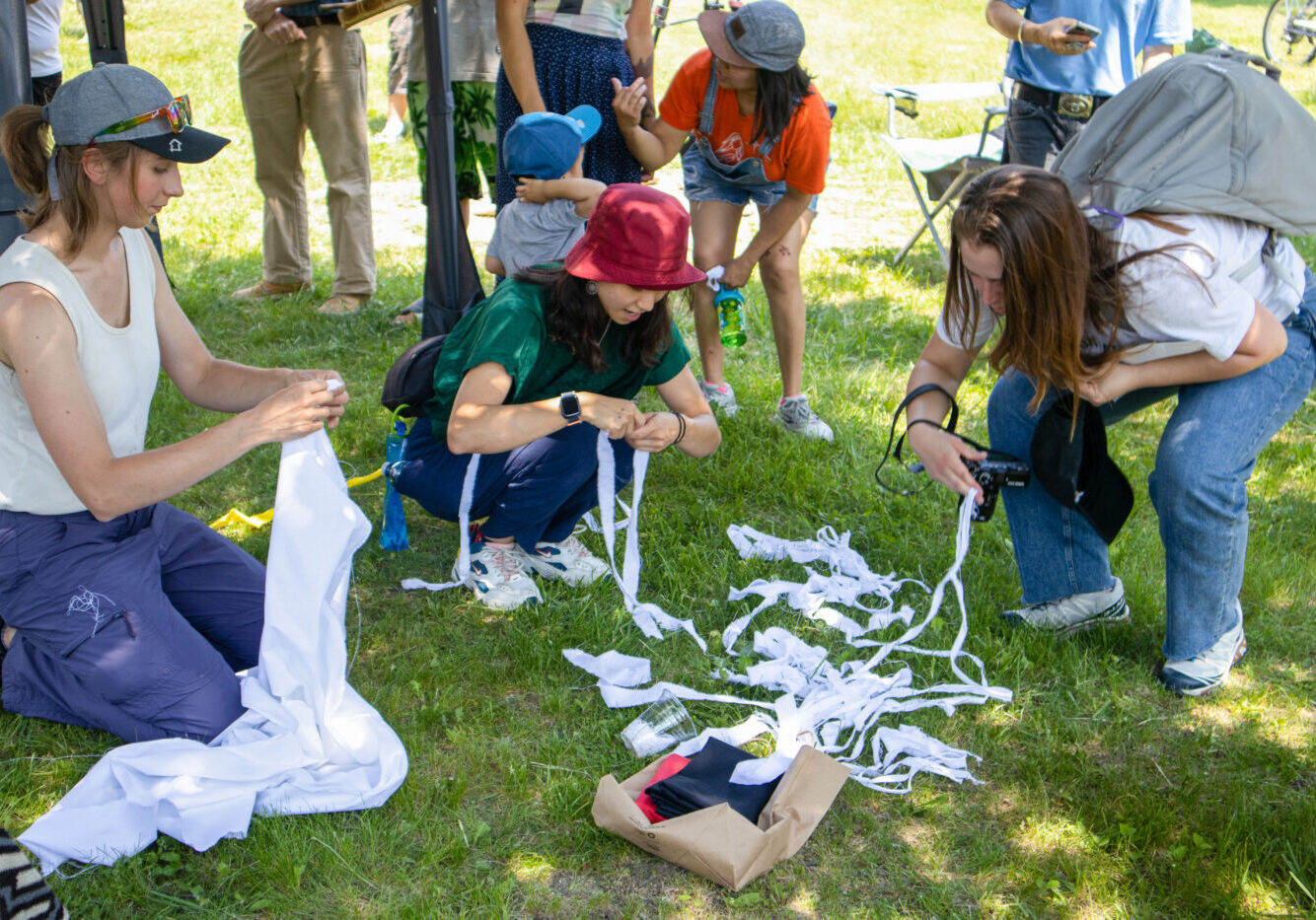
VOLUNTEERS TEAR SHEETS OF COTTON INTO RIBBONS TO BE USED IN THE TREE-BLESSING CEREMONY AT PEAREN PARK.

A LOOK FORWARD
Greenpeace Canada, the Sierra Club and even the world-renowned German folk band Milky Chance are supporting the coalition in its efforts to protect the land.
In a demonstration of solidarity, Milky Chance made a special stop during the Toronto leg of the band’s tour on May 31.
“I think it’s very important, what happens here — communities coming together and simply fighting for the right cause,” said bassist and percussionist Philipp Dausch.
During its visit, Milky Chance participated in the tree-honouring ceremony that ENAGB initiated in January, and that TICOF has carried on since mid-April. The ceremony — which lasts for four days for each tree — includes words of praise, gratitude and respect spoken to each tree individually, the laying of tobacco, smudging, and the tying of cloth ribbons around each tree that’s blessed.
“I am not religious but having people commit so much to honouring nature and the earth right where I live gives me a sense of the sacred, a deeper truth,” said ODonnell. “This reminder — that we can attend to transit needs without dishonouring the natural world, trees and wildlife, around us — is a great gift, and I hope [it] will resonate with the transit planners.”
Fact-Check Yourself
Sources and
further reading
Don't take our word for it!
Check our sources yourself.
